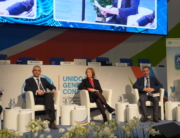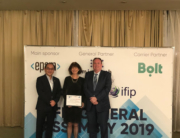Girls and women face many challenges, writes Jo Stewart-Rattray of ACS.

Jo Stewart-Rattray at the UN General Assembly in New York. Photo: Supplied
ACS Vice President of Communities, Jo Stewart-Rattray, recently attended the 67th session of the Commission on the Status of Women (CSW) at the United Nations (UN) headquarters in New York.
Here are her thoughts of the experience:
“As the 67th session of the Commission on the Status of Women (CSW67) was about to commence, there was an excited, electric feeling in the air as the diplomats and NGO observers such as myself filed in to take our seats.
It was extraordinary to see all 193 member states represented and I felt incredibly proud to the see the Australian Official Government Delegation file in headed for the first time by a First Nations woman, Senator the Honourable Malandirri McCarthy, and beside her His Excellency, the Honourable Mitch Fifield, the Permanent Representative of Australia to the United Nations.
The Secretary General of the United Nations, His Excellency Antonio Guterres, who in 2019 declared himself to be a committed feminist on the floor of the General Assembly, this year stated that ‘women’s and girls’ human rights have stalled and have gone backwards. Half of humanity is being left behind…women and girls face a new source of discrimination and bias, digital technology… badly designed algorithms are amplifying sexism… AI will be shaping the world of the future but without women’s equal input, it will continue to be a man’s world and rather than uplifting women and girls with access to education and financial services, technology is often used to harm and control them.’
The General Assembly was absolutely quiet as the speech continued and the Secretary General went on to point out that only 22 per cent of AI workers globally are women.

[From L to R] ACS Strategic Initiatives Executive Sabina Gruetzner; Australia’s Ambassador and Permanent Representative to the United Nations, The Honourable Mitch Fifield; ACS Vice President of Communities, Jo Stewart-Rattray. Photo: Supplied
Given that AI is shaping our future, we need to encourage more women into such study and careers to ensure that one half of the population is not being left out of shaping their own and others’ futures.
Further highlighted was online violence against, and abuse of, women which has grown exponentially in recent times. A UN study of 53 countries revealed that 38 per cent of women had experienced online violence.
The Australian Department of Foreign Affairs and Trade released its statistics in time for CSW67 and they revealed that 79.1 per cent of heterosexual women and 86.6 per cent of lesbian, gay, bisexual or women of another non-heterosexual orientation have experienced online sexual violence facilitated by dating apps.

The Australian Contingent at the 67th session of the Commission on the Status of Women. Photo: Supplied
These are truly stunning and confronting statistics and as a result in some settings, parents and caregivers limit girls’ time on the internet out of growing concerns about girls’ online safety.
There was a call for harassers and platforms alike to be held accountable for such actions as a way to stamp out such behaviour.
As a technology professional I sat stunned into silence to realise that not only are there huge opportunities in technology but there is also a very ugly side “that we must hold a mirror to”.
I want to move the needle in diversity, equality and inclusion and as part of that, I would like to do whatever I can to ensure that women and girls feel safe online and are not put off pursuing study and careers in STEM and in particular in technology because of such adverse experiences.
Sadly, a national study recently showed that only 1 per cent of parents imagined girls to be more interested in technology than boys, compared to 70 per cent of boys. So perhaps we need to ensure that we showcase successful women in STEM careers along the trajectory of their careers to both girls and young women and their parents too, in order to make a change.”
This article was originally published in ACS Information Age





